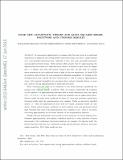| dc.contributor.author | Belloni, Alexandre | |
| dc.contributor.author | Chetverikov, Denis | |
| dc.contributor.author | Kato, Kengo | |
| dc.date.accessioned | 2018-03-19T18:22:00Z | |
| dc.date.available | 2018-03-19T18:22:00Z | |
| dc.date.issued | 2015-02 | |
| dc.identifier.issn | 03044076 | |
| dc.identifier.issn | 0304-4076 | |
| dc.identifier.uri | http://hdl.handle.net/1721.1/114217 | |
| dc.description.abstract | In econometric applications it is common that the exact form of a conditional expectation is unknown and having flexible functional forms can lead to improvements over a pre-specified functional form, especially if they nest some successful parametric economically-motivated forms. Series method offers exactly that by approximating the unknown function based on k basis functions, where k is allowed to grow with the sample size n to balance the trade off between variance and bias. In this work we consider series estimators for the conditional mean in light of four new ingredients: (i) sharp LLNs for matrices derived from the non-commutative Khinchin inequalities, (ii) bounds on the Lebesgue factor that controls the ratio between the L∞ and L[superscript 2]-norms of approximation errors, (iii) maximal inequalities for processes whose entropy integrals diverge at some rate, and (iv) strong approximations to series-type processes. These technical tools allow us to contribute to the series literature, specifically the seminal work of Newey (1997), as follows. First, we weaken considerably the condition on the number k of approximating functions used in series estimation from the typical k[superscript 2] /n→0 to k/n→0, up to log factors, which was available only for spline series before. Second, under the same weak conditions we derive L[superscript 2] rates and pointwise central limit theorems results when the approximation error vanishes. Under an incorrectly specified model, i.e. when the approximation error does not vanish, analogous results are also shown. Third, under stronger conditions we derive uniform rates and functional central limit theorems that hold if the approximation error vanishes or not. That is, we derive the strong approximation for the entire estimate of the nonparametric function. Finally and most importantly, from a point of view of practice, we derive uniform rates, Gaussian approximations, and uniform confidence bands for a wide collection of linear functionals of the conditional expectation function, for example, the function itself, the partial derivative function, the conditional average partial derivative function, and other similar quantities. All of these results are new. | en_US |
| dc.publisher | Elsevier BV | en_US |
| dc.relation.isversionof | http://dx.doi.org/10.1016/J.JECONOM.2015.02.014 | en_US |
| dc.rights | Creative Commons Attribution-NonCommercial-NoDerivs License | en_US |
| dc.rights.uri | http://creativecommons.org/licenses/by-nc-nd/4.0/ | en_US |
| dc.source | arXiv | en_US |
| dc.title | Some new asymptotic theory for least squares series: Pointwise and uniform results | en_US |
| dc.type | Article | en_US |
| dc.identifier.citation | Belloni, Alexandre, et al. “Some New Asymptotic Theory for Least Squares Series: Pointwise and Uniform Results.” Journal of Econometrics, vol. 186, no. 2, June 2015, pp. 345–66. | en_US |
| dc.contributor.department | Massachusetts Institute of Technology. Department of Economics | en_US |
| dc.relation.journal | Journal of Econometrics | en_US |
| dc.eprint.version | Author's final manuscript | en_US |
| dc.type.uri | http://purl.org/eprint/type/JournalArticle | en_US |
| eprint.status | http://purl.org/eprint/status/PeerReviewed | en_US |
| dc.date.updated | 2018-02-20T18:19:50Z | |
| dspace.orderedauthors | Belloni, Alexandre; Chernozhukov, Victor; Chetverikov, Denis; Kato, Kengo | en_US |
| dspace.embargo.terms | N | en_US |
| mit.license | PUBLISHER_CC | en_US |
